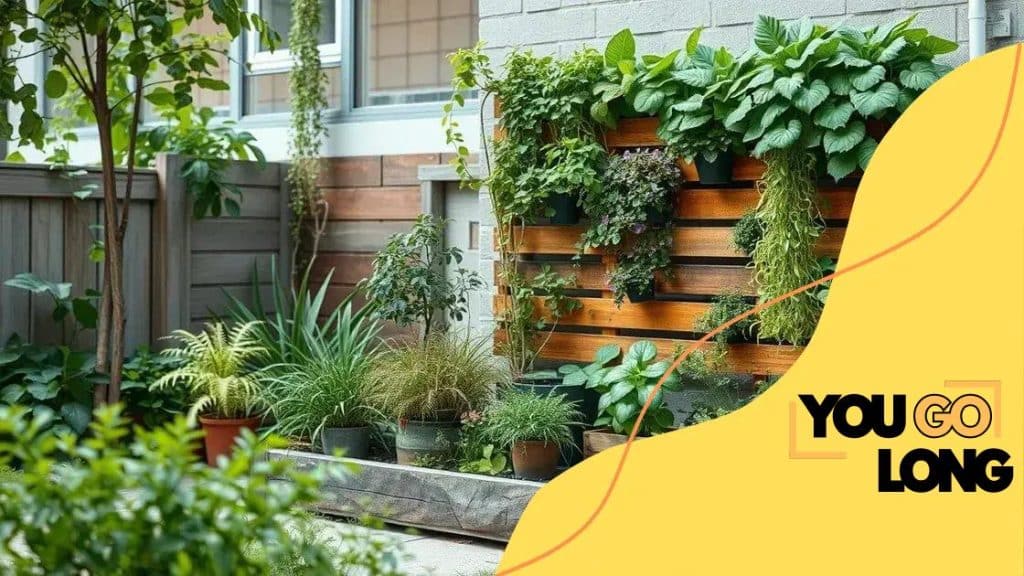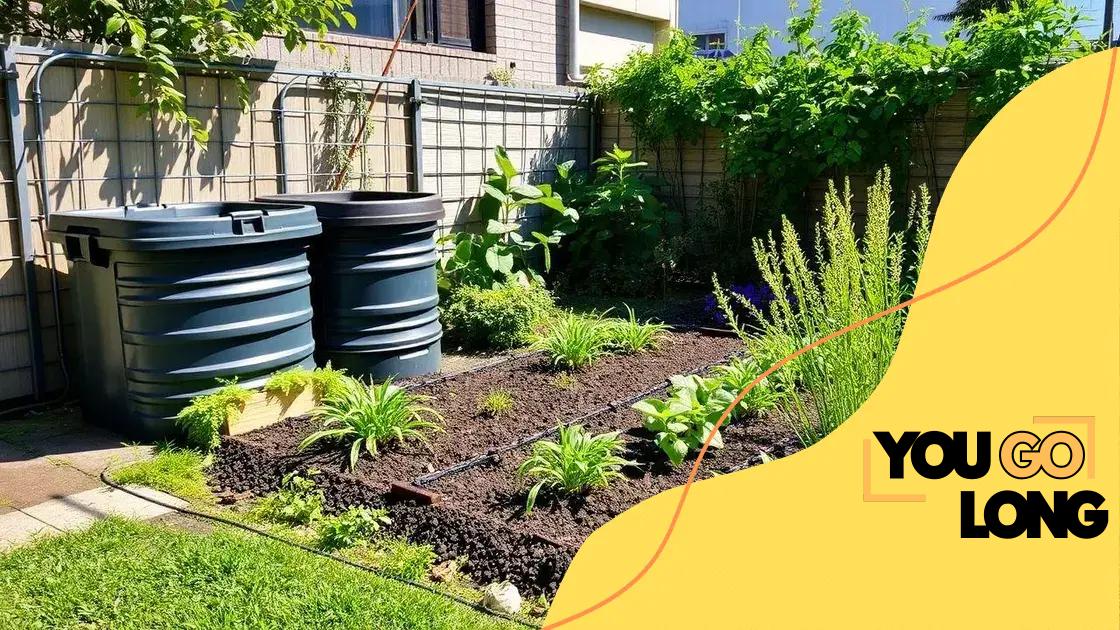How to create an eco-friendly garden in urban spaces

Advertisement
Creating an eco-friendly garden in urban spaces involves choosing the right plants, implementing vertical gardening, utilizing water conservation techniques, and using recycled materials for a sustainable and vibrant outdoor area.
Creating an eco-friendly garden in urban spaces may seem challenging, but it’s more achievable than you think. Imagine turning your small balcony or yard into a vibrant green oasis. Ready to explore practical tips that can help you get started?
Choosing the right plants for urban gardens
Choosing the right plants for your urban garden is crucial to creating a successful and thriving space. With limited sunlight and space, it’s essential to select plants that will flourish in your specific environment. The diversity of options ensures that even urban dwellers can enjoy eco-friendly gardening.
Consider Your Environment
Before you decide on the plants, think about the conditions in your area. Observe how much sunlight your space receives and note the soil quality. For example, if your garden gets partial shade, you can select plants that prefer indirect sunlight.
Advertisement
Best Plants for Urban Gardens
Here are some excellent plant options for urban settings:
- Succulents: Great for dry areas and require minimal watering.
- Herbs: Easy to grow and perfect for small spaces.
- Native plants: Adapted to your local climate, making them resilient and low-maintenance.
- Vegetables: Compact varieties are perfect for small balconies.
When selecting plants, consider their growth habits and how they match your garden’s layout. Avoid overcrowding your plants; instead, aim for a balanced aesthetic and healthy growth. Ensuring a mix of colors and heights can also add visual interest to your garden.
In smaller spaces, you might think about using containers. Container gardening allows for better control over soil quality and watering. Plus, it adds flexibility to position your plants in the best light. Whether you choose pots or raised beds, the right plants will create an inviting urban oasis.
Advertisement
Ultimately, having the right plants in your eco-friendly garden will enhance its beauty and functionality. With thoughtful selection, you can create a lush environment that contributes positively to your neighborhood.
Benefits of vertical gardening
Vertical gardening offers numerous advantages, especially for urban environments where space is limited. By growing plants upwards rather than outwards, you can maximize your garden’s potential. This approach not only beautifies your space but also enhances its functionality.
Space Efficiency
One of the main benefits of vertical gardening is space efficiency. In small apartments or yards, it’s often challenging to find enough room for traditional gardens. Vertical gardens allow you to utilize walls, fences, and even balconies, making the most of every inch.
Improved Air Quality
Plants naturally filter the air, and vertical gardens can add significant greenery to urban areas. This helps to improve air quality, making the environment healthier for you and your neighbors. By planting a variety of species, you can enhance biodiversity in your locality.
Temperature Regulation
Another important advantage is temperature regulation. Vertical gardens can help cool down buildings, lowering energy costs, especially during hot summer months. The greenery acts as an insulator, which keeps indoor temperatures more comfortable.
- Less Soil Requirement: Many vertical gardening systems use soil-efficient methods, requiring less overall soil volume.
- Accessibility: Easier access to plants for watering and harvesting, reducing strain on your back.
- Aesthetic Appeal: Adds visual interest to your home, creating a stunning focal point.
- Versatility: Allows for a wide range of plants, including flowers, herbs, and vegetables.
The visual impact of a vertical garden can transform any bland space into a vibrant one. Imagine green walls full of life and color, attracting attention and admiration. This not only enhances your immediate environment but can also increase property value.
By choosing vertical gardening, you’re engaging in an eco-friendly practice that contributes positively to both your quality of life and the environment. This gardening method provides accessibility and creativity, making it perfect for any urban gardener.
Sustainable gardening practices

Sustainable gardening practices are essential for creating an eco-friendly garden that thrives in urban spaces. These methods focus on nurturing the environment while providing beautiful and productive gardens. By adopting sustainable techniques, you not only benefit your local ecosystem but also contribute to your community.
Organic Gardening
Using organic gardening practices means avoiding synthetic fertilizers and pesticides. Instead, opt for natural alternatives that nourish the soil and plants without harming the environment. Composting kitchen scraps and garden waste is an excellent way to enrich your soil naturally.
Water Conservation
Water conservation is crucial, especially in urban areas where water may be limited. Implementing rainwater harvesting systems can help collect water for your garden. Mulching around plants also reduces water evaporation and keeps the soil moist.
- Drip irrigation: Provides targeted watering directly to plant roots, minimizing waste.
- Native plants: Require less water and maintenance, making them ideal for sustainable gardens.
- Hydroponics: A method of growing plants in water, which can save soil and water.
Furthermore, integrating companion planting can enhance biodiversity. Certain plant combinations can help deter pests naturally, reducing the need for chemical intervention. For instance, planting marigolds with vegetables may keep unwanted insects at bay.
Another effective sustainable practice is rotating your crops each season. This prevents soil depletion and reduces the buildup of pests and diseases. By allowing different plants to grow in the same area over time, you maintain healthy soil.
Incorporating these sustainable gardening techniques not only conserves resources but also creates a lush, vibrant garden that can thrive in any urban setting. With each small change, you’re making a significant impact on the environment around you.
How to use recycled materials
Using recycled materials in your garden not only helps reduce waste but also adds unique character to your eco-friendly space. By incorporating items that might otherwise be discarded, you create a sustainable garden that’s both functional and creative.
Types of Recycled Materials
There are many types of recycled materials you can use. For example, old pallets can be transformed into raised garden beds. By simply stacking and securing them, you create a perfect frame for your plants. Similarly, glass jars can serve as plant cloches, protecting young sprouts from harsh weather.
Creative Upcycling Ideas
Here are some fun ideas for using recycled materials:
- Wine Bottles: Cut bottles in half to create borders for garden beds or use them to form a unique drip irrigation system.
- Old Tires: Paint them in bright colors and use them as planters or garden decorations.
- Food Containers: Use old yogurt cups or containers to start seedlings indoors before transferring them to your garden.
By thinking creatively, you can repurpose many household items. Even old newspapers can be used as a layer of mulch to suppress weeds and retain moisture in the soil. Simply tear them into strips and spread them around your plants.
Additionally, using these materials doesn’t just cut costs; it also gives your garden a personal touch. Each repurposed item tells a story, making your garden a reflection of your personality and values.
Moreover, incorporating recycled materials promotes a cycle of sustainability that benefits the environment. It encourages a mindset of resourcefulness and creativity. As you experiment with different items, you’ll discover countless ways to enhance your garden while contributing to a healthier planet.
Water conservation techniques for gardening
Water conservation techniques are vital for maintaining a healthy garden while minimizing waste. With limited resources often available in urban areas, implementing effective strategies is essential.
Efficient Watering Methods
One of the best ways to conserve water is by using efficient watering methods. Instead of watering plants randomly, consider using drip irrigation, which delivers water directly to the roots. This method reduces evaporation and runoff, ensuring that your plants receive the moisture they need without waste.
Rainwater Harvesting
Rainwater harvesting is another effective technique. Installing a rain barrel to collect rainwater from your roof can provide a free and sustainable water source for your garden. This water is typically of good quality and can be used during dry spells.
- Mulching: Applying a layer of organic mulch around your plants helps retain moisture in the soil.
- Soil Management: Improving soil health with compost increases its water-holding capacity.
- Timing: Watering early in the morning or late in the evening reduces evaporation and allows for better absorption.
Another helpful method is grouping plants with similar water needs together. This practice, known as hydro-zoning, ensures that you only water the areas that require it, which conserves overall water usage. Additionally, regularly checking for leaks in hoses and connections can prevent unnecessary water loss.
By adopting these water conservation techniques, not only will you save money, but you will also create a more sustainable garden that contributes positively to your local ecosystem. Small adjustments in your gardening routine can make a big difference in conserving this precious resource.
In conclusion, creating an eco-friendly garden in urban spaces is not only possible but also rewarding. By choosing the right plants, utilizing vertical gardening, and implementing sustainable practices, you can transform small areas into green sanctuaries. Water conservation techniques further enhance your garden’s resilience. Most importantly, using recycled materials adds unique character while protecting the environment. These steps not only benefit your local ecosystem but also bring joy and beauty to your home.
FAQ – Frequently Asked Questions about Eco-Friendly Gardening in Urban Spaces
What are the best plants for small urban gardens?
Plants like herbs, native flowers, and succulents are ideal for small spaces as they require less water and care.
How can I conserve water in my garden?
Utilize drip irrigation, collect rainwater in barrels, and apply mulch to reduce evaporation and keep the soil moist.
What are some creative ways to use recycled materials in gardening?
You can turn old pallets into raised beds, use wine bottles for garden borders, and repurpose food containers for starting seedlings.
How do vertical gardens benefit urban spaces?
Vertical gardens maximize limited space, improve air quality, and can enhance energy efficiency in buildings by insulating walls.





